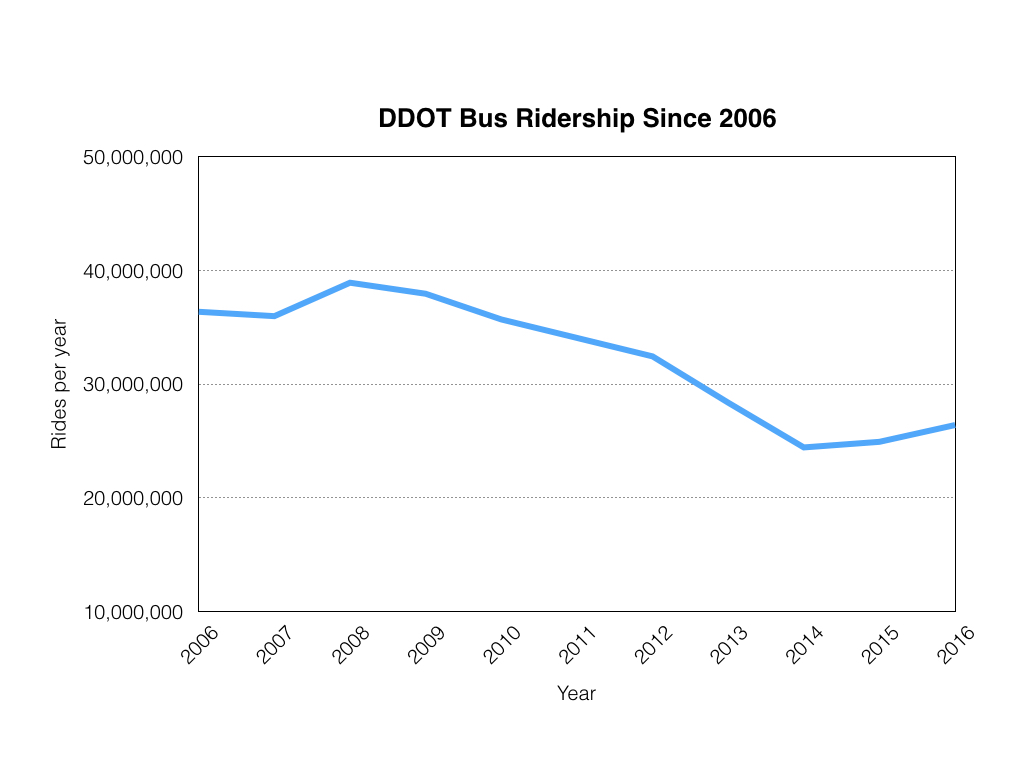
News out of Detroit this week is trumpeting Friday’s launch of the Q-Line, a privately funded streetcar that runs 3.3 miles in mixed traffic along Woodward Avenue, the city’s Main Street. Without any knowledge of whether people will actually use it, local columnists and editorial writers are already calling for streetcar expansion.
But beyond the one-off rail line, which is not integrated via governance, schedules or stops — and only partially with regard to fares — with the city’s bus network, there’s much more going on with transit in Detroit than you will find this week in the pages of the Free Press or Crain’s.
The briefest description is that city buses operated by the badly named Detroit Department of Transportation (DDOT) have undergone a successful management revolution under Mayor Mike Duggan, and are now offering the most reliable service the city has seen for years. The bus system’s current challenge is to convince locals who suffered through severe cutbacks, abysmal performance and high crime levels on buses that the rebound is real.
As recently as January 2014, fewer than 60% of scheduled DDOT buses actually left the depots. The system still suffers today from this reputation of radical unreliability. It was in fact big news in September 2015 when every scheduled bus made its run for the first time in many years.
Duggan confronted management and institutional erosion by firing the head of DDOT within a few weeks of taking office in 2014. Under his administration, the system has purchased new buses, added 100 drivers and begun the process of rebuilding service, which is still far below the levels provided (at least on paper) before the city’s 2013 bankruptcy.
In 2016, DDOT instituted the first transit service increases Detroit had seen in a decade. In early 2016, the city had no round-the-clock buses. Service increases remedied this, and responded to a much-changed city by creating new routes, connecting still-populous neighborhoods to the mid-city area, and extending service into neighboring Dearborn. Within the last year, DDOT has created a total of six new routes and extended nine to 24 hour operation. In all, the increases amount to 1,500 additional bus runs per week. Frequency and weekend service are up significantly with daytime service intervals under 10 minutes on some key routes.

Even mid-day crosstown buses are crowded!
The mayor, who once managed the suburban SMART bus system, said last summer that “One of the worst things the city ever did was cut its bus service because it cut people off from their ability to get to a job.” On several occasions he has reiterated his commitment to “continuing to add service every chance we get.”
The Duggan administration has also engineered a turnaround regarding crime on transit. Security incidents on DDOT buses are down 62% since 2013, thanks to creation of a new transit police unit and installation of interior and exterior cameras on all buses. Fred Westbrook Jr., president of Amalgamated Transit Union Local 26, told the Free Press last summer that extra police boarding buses have led to a “tremendous” change. “There’s a big difference since the transit police came on board, as far as physical assaults [are concerned].”

The city’s challenge now is to tell this story in manner compelling enough to bring more people back onto buses. Rebranding the DDOT system with a new look and more compelling name would help. The system also needs to update and simplify its antiquated and mostly cash-based fare system to compete with the one-click ease of using Uber and similar services. It also should consider redeploying some bus service out of heavily depopulated areas in favor of on-demand options, so drivers and buses can deliver more bang for the buck with more frequent service on major routes.
Detroit’s public conversation about transit once the Q-Line begins service is difficult to predict. Woodward Avenue is also the route of the city’s most heavily patronized buses. The construction of streetcar stops on separate blocks from bus stops along Woodward has rubbed some residents the wrong way. In a city with little to no traffic congestion, the buses may well provide faster service. Whether both can or should happily coexist along the same major street is unclear, but usage trends over the rest of the year should begin to provide answers and direction.
 On the Brink: Will WMATA’s Progress Be Erased by 2024?
On the Brink: Will WMATA’s Progress Be Erased by 2024?
The experience of being a WMATA rider has substantially improved over the last 18 months, thanks to changes the agency has made like adding off-peak service and simplifying fares. Things are about to get even better with the launch of all-door boarding later this fall, overnight bus service on some lines starting in December, and an ambitious plan to redesign the Metrobus network. But all of this could go away by July 1, 2024.
Read More A Bus Agenda for New York City Mayor Eric Adams
A Bus Agenda for New York City Mayor Eric Adams
To create the “state-of-the-art bus transit system” of his campaign platform, Mayor Adams will have to both expand the quantity and improve the quality of bus lanes. We recommend these strategies to get it done.
Read More